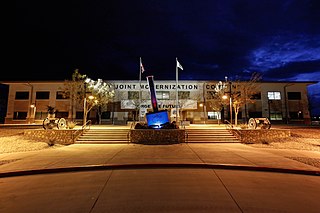Military science is the study of military processes, institutions, and behavior, along with the study of warfare, and the theory and application of organized coercive force. It is mainly focused on theory, method, and practice of producing military capability in a manner consistent with national defense policy. Military science serves to identify the strategic, political, economic, psychological, social, operational, technological, and tactical elements necessary to sustain relative advantage of military force; and to increase the likelihood and favorable outcomes of victory in peace or during a war. Military scientists include theorists, researchers, experimental scientists, applied scientists, designers, engineers, test technicians, and other military personnel.
Military doctrine is the expression of how military forces contribute to campaigns, major operations, battles, and engagements.
Network-centric warfare, also called network-centric operations or net-centric warfare, is a military doctrine or theory of war that seeks to translate an information advantage, enabled in part by information technology, into a competitive advantage through the robust computer networking of well informed geographically dispersed forces. It was pioneered by the United States Department of Defense in the 1990s.

Allied Command Transformation (ACT) is a military command of the North Atlantic Treaty Organization (NATO), formed in 2003 after restructuring.
The Joint Capabilities Integration and Development System (JCIDS), is the formal United States Department of Defense (DoD) process which defines acquisition requirements and evaluation criteria for future defense programs. JCIDS was created to replace the previous service-specific requirements generation system that allowed redundancies in capabilities and failed to meet the combined needs of all US military services. In order to correct these problems, JCIDS is intended to guide the development of requirements for future acquisition systems to reflect the needs of all four services by focusing the requirements generation process on needed capabilities as requested or defined by one of the US combatant commanders. In an ideal implementation of the JCIDS process, regional and functional combatant commanders give early and continuous feedback into the acquisition and sustainment processes to ensure their current and evolving requirements are known and met.
Strategic communication can mean either communicating a concept, a process, or data that satisfies a long term strategic goal of an organization by allowing facilitation of advanced planning, or communicating over long distances usually using international telecommunications or dedicated global network assets to coordinate actions and activities of operationally significant commercial, non-commercial and military business or combat and logistic subunits. It can also mean the related function within an organization, which handles internal and external communication processes. Strategic communication can also be used for political warfare.

Command and control (C2) is a "set of organizational and technical attributes and processes ... [that] employs human, physical, and information resources to solve problems and accomplish missions" to achieve the goals of an organization or enterprise, according to a 2015 definition by military scientists Marius Vassiliou, David S. Alberts and Jonathan R. Agre. The term often refers to a military system.
The Command and Control Research Program (CCRP) was an active DoD Research Program from 1994 to 2015. It was housed within the Office of the Assistant Secretary of Defense (NII) and it focused upon (1) improving both the state of the art and the state of the practice of command and control (C2) and (2) enhancing DoD's understanding of the national security implications of the Information Age. It provides "Out of the Box" thinking and explores ways to help DoD take full advantage of Information Age opportunities. The CCRP served as a bridge between the operational and technical communities and enhanced the body of knowledge and research infrastructure needed for future progress.
David Stephen Alberts is a former American Director of Research for the Office of the Assistant Secretary of Defense for Networks and Information Integration (NII).
Capability management is a high-level integrative management function, with particular application in the context of defense.
DOTMLPF is an acronym used by the United States Department of Defense. DOTMLPF is defined in The Joint Capabilities Integration Development System, or JCIDS Process. The JCIDS process provides a solution space that considers solutions involving a simulation of doctrine, organization, training, materiel, leadership and education, personnel, and facilities required to accomplish a mission. Because combatant commanders define requirements in consultation with the Office of the Secretary of Defense (OSD), they are able to consider gaps in the context of strategic direction for the total US military force and influence the direction of requirements earlier in the acquisition process, in particular, materiel.
Harold Adrian Linstone was a German-American mathematician, consultant, futurist and University Professor Emeritus of Systems Science at Portland State University and a specialist in applied mathematics.

NATO CCD COE, officially the NATO Cooperative Cyber Defence Centre of Excellence is one of NATO Centres of Excellence, located in Tallinn, Estonia. The Centre was established on 14 May 2008, it received full accreditation by NATO and attained the status of International Military Organisation on 28 October 2008. NATO Cooperative Cyber Defence Centre of Excellence is an International Military Organisation with a mission to enhance the capability, cooperation and information sharing among NATO, its member nations and partners in cyber defence by virtue of education, research and development, lessons learned and consultation.
The Navy Warfare Development Command (NWDC) is a command of the United States Navy for the generation and development of innovations in concepts and doctrine for enhanced operational level maritime capability and integration in joint and coalition activities. The NWDC is currently located at Naval Station Norfolk, VA.

The U.S. Army Joint Modernization Command, or JMC, based in Fort Bliss, Texas, gains insights from "Fight Tonight" units about future ways of fighting, future technology, and force structure during realistic live, constructive, and/or simulated training exercises. Joint Modernization Command is subordinate to the Army Futures & Concepts Center in Joint Base Langley-Eustis, Virginia; both report to the U.S. Army's newest Four-Star Command, the Army Futures Command (AFC) based in Austin, Texas.
Intent is the desired outcome of a military operation. It is a key concept in 21st century military operations and is a vital element to facilitate subordinates' initiative and collaboration and cooperation amongst team members in joint operations.
A battle lab or battle laboratory is an organization dedicated to studying changes in the military.
Data thinking is the generic mental pattern observed during the processes of picking a subject to start with, identifying its parts or components, organizing and describing them in an informative fashion that is relevant to what motivated and initiated the whole processes.

Federated Mission Networking (FMN) is a significant initiative to help ensure interoperability and operational effectiveness of the North Atlantic Treaty Organization, it is a key contribution to the Connected Forces Initiative, helping Allied and Partner forces to better communicate, train and operate together. This includes the NATO Command Structure as well as the NATO Force Structure. The purpose of FMN is ultimately to support Command, Control, Communications, Computers, Intelligence, Surveillance and Reconnaissance (C4ISR) and decision-making in operations by enabling a rapid instantiation of mission networks. Including the NATO Command Structure, 35 nations have joined the FMN initiative as so called "FMN Affiliates" and work together under the FMN Framework Process to coordinate the design, development and delivery of operational and technical capabilities required to conduct net-centric operations. Each development increment is referred to as an "FMN Spiral". The respective requirements, architecture, standards, procedural and technical instructions are documented in so called "FMN Spiral Specifications". FMN Spiral Specifications are based on well known standards and best practices, hence supported by most off-the-shelf products and vendor neutral. TACOMS standards and profiles specify a common, technology and topology independent network interoperability layer for federated mission networks. There is also a rolling 10-year FMN Spiral Specification Roadmap of the envisioned future capabilities. At the same time, the Coalition Interoperability Assurance and Validation (CIAV) process ensures that current interoperability issues are being identified and fed back into FMN capability development.

NATO Mountain Warfare Centre of Excellence is one of NATO Centres of Excellence, located in Poljče, 27, 4275, Begunje na Gorenjskem, Slovenia. It assists NATO member countries, partners, other countries and international organizations, in order to enhance mountain warfare capabilities.